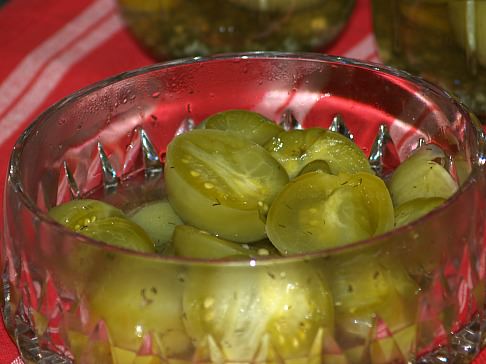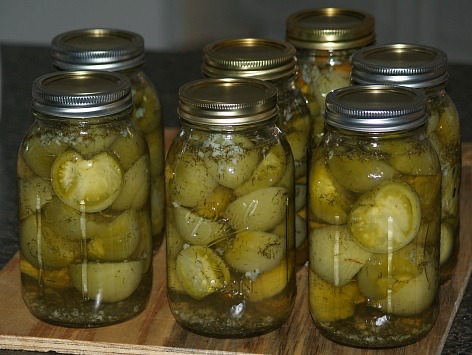- Painless Cooking
- Canning Techniques and Recipes
- How to Can Vegetables
How to Can Vegetables
When learning how to can vegetables, there are many things that you should know before attempting the task. It is necessary to process “low acid” vegetables in a pressure canner to ensure good quality. Many vegetables can be raw packed or hot packed; some can only be hot packed.
There are vegetables which do not can well at all; these are recommended for only freezing. I am sure you will develop or already have favorite ways of preserving certain vegetables. I do not like peas which are canned; I prefer them frozen because the canned peas are just too mushy. Likewise, I prefer most peppers frozen except when I can hot peppers without the pressure canner and store them in the refrigerator. Green beans are different; I prefer them canned over being frozen. It is simply a matter of taste!
NOTE: Although many of us consider (TOMATOES) when
learning how to can vegetables, they are actually fruit. Tomatoes can
range from very high acid to very low acid therefore causing a big
controversy as to the best way of canning them. USDA recommends that all
tomatoes be hot packed and then processed in a boiling water bath or in
a pressure canner.
As you learn how to can vegetables the following vegetables are not recommended for canning: broccoli, Brussels sprouts, cabbage, cauliflower, eggplant, mushrooms, hot peppers, turnips, parsnips, rutabagas, zucchini and summer squash. Although these are not recommended for canning, many can be with a different process such as “pickling them” which are very delicious; or as with cabbage making sauerkraut can be very good also.
Artichokes, dried beans, red beets, celery, okra, onions, sweet peppers, potatoes, sweet potatoes, spinach and other greens must be hot packed (no raw packing). While this is true, many of these I do not liked canned at all; I prefer sweet peppers, celery and all greens when frozen much better. It is suggested to only raw pack snow peas or sugar peas and the processing time in the canner is only 20 to 25 minutes. Again, I like these much better when frozen.
NOTE: A difference in altitude plays an important role when learning how to can vegetables; or in canning anything. Higher elevations require more pounds of pressure; recipes given are usually for less than 2000 feet above sea level.
If learning how to can vegetables, CANNING CORN can be very easy because it is one of the vegetables which can be raw packed; either whole kernel corn or cream style corn. Simply husk the corn, remove the silk and wash. For whole kernel corn cut the corn from the cob about 2/3 the depth of the kernels and pack lightly in hot sterilized jars. Cover corn with boiling water leaving 1 inch head space. Process under 10 pounds of pressure for 55 minutes for pint jars; 85 minutes quart jars. For canning cream style corn, cut the kernels off the cob about half way; then scrape the cobs. Pack loosely in pint jars and fill with boiling water to 1 inch from top. Process with 10 pounds of pressure for 95 minutes.
When CANNING GREEN BEANS, you can use the raw pack or hot pack but they must be processed in a pressure canner. Start by thoroughly washing freshly gathered young tender crisp beans in lots of fresh water. Remove beans from the water and drain. Trim off the ends and break into pieces. At this point you can RAW PACK into hot sterilized jars; or for HOT PACK, cover with boiling water and cook for 5 minutes. After packing green beans in hot sterilized jars, cover beans with boiling water leaving a 1 inch head space. Wipe the top of jars and the threads with a clean damp cloth to remove any pieces that would hamper the lids sealing. Place lids on and screw the rims on tightly. Place the jars in a pressure canner and follow the manufacturer’s instructions for processing. At altitudes below 2000 feet, bring pressure to 10 pounds and keep the pressure steady for 20 minutes for pints and 25 minutes for quarts.
Remove the canner for the heat and let pressure fall to zero; wait 2 minutes and slowly open the vent. Open the canner and remove the jars. Let the jars set at room temperature out of drafts to cool for about 12 hours. Check to make sure jars are sealed by pressing down on the center of the lids.
NOTE: If you are learning how to can vegetables, when making recipes containing lots of vinegar, the hot mixtures often can be placed in hot sterilized jars and sealed with not pressure canning or hot water bath.
How to Can Vegetables
GARLIC DILL GREEN TOMATOES RECIPE
- Green tomatoes (For 7 quart jars)
- 6 Cups vinegar
- 12 Cups water
- 9 Tablespoons salt
- ¾ Teaspoon (For each jar)
- ¾ Teaspoon minced garlic (For each jar)
- 1/8 Teaspoon red pepper flakes (For each jar) OPTIONAL
Combine water, vinegar and salt in a large kettle; bring to a boil and reduce to a simmer.
Cut washed green tomatoes into chunks; pack in clean sterilized jars leaving 1 inch headspace.
Add to each jar the garlic, dill and red pepper flakes; fill jars with hot brine leaving ¼ inch headspace.
Adjust lids; process in hot water bath for 10 minutes.
CORN SALAD RECIPE
- 12 Ears corn, cut off cobs
- 12 Medium onions
- 1 Medium cabbage
- 3 Green bell peppers
- Salt to taste
- 3 Pints vinegar
- 1 Small jar prepared mustard
- 1 Tablespoon white mustard seed
- 3 Pints sugar
Chop all vegetables fine and combine with remaining ingredients in heavy pan.
Bring mixture to a boil stirring to make sure it is thoroughly hot.
Fill hot sterilized jars and seal immediately.
PICKLED OKRA RECIPE
- 3 Cups vinegar
- 1 ½ Cups water
- 7 Tablespoons sugar
- 1 Tablespoon salt
- 3 Pints small okra
- 1 Hot pepper pod per pint jar
Cut ends of okra but leave stem end on.
Cook okra, vinegar, water, sugar and salt only until okra can be pierced with toothpick.
Add 1 hot pepper pod to each hot sterilized pint jar and fill with okra mixture; seal immediately.
GREEN TOMATO RELISH RECIPE
When
learning how to can vegetables also learn how to can green tomatoes;
they are very good in recipes like this green tomato relish.
- 10 Green tomatoes
- 10 onions
- 1 Pound carrots
- 9 Green bell peppers
- 9 Red bell peppers
- 1 Small bunch celery
- 3 Tablespoons coarse salt
- 3 Cups cider vinegar
- 6 Cups sugar
- 1 Tablespoon celery seed
- 1 Tablespoon mustard seed
Grind together the tomatoes, onions, carrots, peppers and celery; add coarse salt and let stand 1 hour.
Squeeze and drain off all the liquid.
Heat vinegar, sugar, celery seed and mustard seed until sugar dissolves.
Pour over vegetable mixture and let set for 15 minutes.
PICKLED PEA PODS
When you learn how to can vegetables, do not overlook recipes like these pickled pea pods; they make a great condiment recipe.
- 4 Quarts edible pea pods
- 2 Tablespoons crushed red pepper per jar
- 2 Tablespoons whole mustard seeds per jar
- 2 Tablespoons dill seed per jar
- 12 Cloves garlic
- 5 Cups vinegar
- 5 Cups water
- ½ Cup salt
Wash peas and place in 12 sterilized pint jars; divide evenly.
In each jar add ½ teaspoon of the red pepper, ½ teaspoon of the mustard seed, ½ teaspoon dill and 1 clove garlic.
Combine the vinegar, water and salt in a saucepan; bring to a boil.
Pour mixture over the peas and spices I jars; process for 5 minutes in boiling water bath.
PICKLED VEGETABLE RECIPE
This is a tasty recipe when you learn how to can vegetables.
- 1 ¼ Cups sliced cucumbers
- 2 Cups sliced carrots
- 2 Cups sliced celery
- 2 Cups peeled and sliced onions
- 2 Red sweet peppers seeded and sliced
- 3 Cups cauliflower
- 2 Hot pepper seeded and cut in rings
- 1 Cup canning salt
- 4 Quarts water
- 2 Cups sugar
- ¼ Cup mustard seeds
- 2 Tablespoons celery seeds
- 6 ½ Cups vinegar
Combine all vegetables and blend well.
Dissolve salt in cold water, pour over vegetables and let stand 12 to 18 hours in cool place; drain.
Combine sugar, mustard seeds, celery seeds and vinegar; boil for 3 minutes.
Add vegetables and simmer for 5 minutes; pack in hot sterilized pint jars covering with the hot liquid.
Put lids on tightly and process in boiling water bath for 15 minutes.






